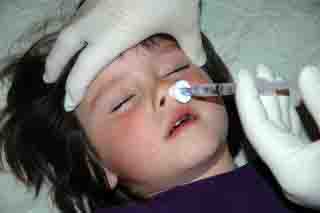Intranasal and intraoral lidocaine for topical anesthesia - dosing protocol:
NASOPHARYNGEAL PROCEDURES: NASAL AND ORAL 4% LIDOCAINE (with or without oxymetazoline)
Indications: To reduce pain and gagging
and induce vasoconstriction in patients requiring:
- Nasogastric tubes
- Nasal intubations
- Nasal fiberoptic procedures
Alternate Indication: As an option to treat selected migraine, cluster or ice pick temporal headaches by blocking the sphenopalatine ganglion in the nasal cavity
- Load a 5cc syringe with 4.5 ml of 4% lidocaine
and attach nasal atomizer (adult dose)
- A topical vasoconstrictor such as oxymetazoline can also be used either as a separate spray or mixed with the lidocaine to shrink mucosal membranes and constrict blood vessels. This will reduce risk of epistaxis during the procedure and open the nasal cavity to allow easier passage of the device.
- Give the patient a tissue to capture any runoff solution
- Place atomizer within the selected nostril
- Briskly compress syringe to administer 1.5 ml of atomized spray into the nose. If the patient is awake, ask them to inhale through their nose during the time you spray.
- Remove atomizer from the nostril and open the patient’s mouth. Spray the remaining 3 ml of 4% lidocaine into throat. If the patient is awake, ask them to gargle and swallow. (Oral lidocaine not needed to treat headaches)
- Lubricate end of NGT or ETT.
- Squirt lidocaine jelly or viscous lidocaine into nostril using syringe or nasal atomizer (it will come out as a stream) to further anesthetize the nose.
- After the lidocaine has had 3 minutes to take effect, insert the device as per standard protocol. If anesthesia is inadequate, repeat with ½ dose and allow several more minutes to take effect.
Topical Lidocaine dosing protocol
Indication: Topical anesthetics are partially absorbed into the blood stream and if high doses result may lead to cardiovascular (arrhythmias) and neurologic (seizures) toxicity. Lidocaine is one of the safer topical anesthetics but can still lead to these complications if improperly applied. To prevent the risk of these toxic side effects, it is important to limit the volume of topically applied lidocaine to doses well within the safety range.
Dose: A reasonable dose that is safe
for topical lidocaine is 4 mg/kg. (Doses as high as 7 mg/kg
may be considered safe if a topical vasoconstrictor (oxymetazoline) is
applied prior or simultaneously to the lidocaine.)
|
Comments:
- When performing a nasal procedure, strongly consider a topical vasoconstrictor in addition to the lidocaine to prevent bleeding and shrink the nasal mucosa. This can be mixed with the lidocaine or applied separately. Oxymetazoline probably has best safety profile in children.
- When possible allow a full 3 minutes for lidocaine to take complete effect before performing the procedure.
 Therapeutic
Intranasal Drug Delivery
Therapeutic
Intranasal Drug Delivery